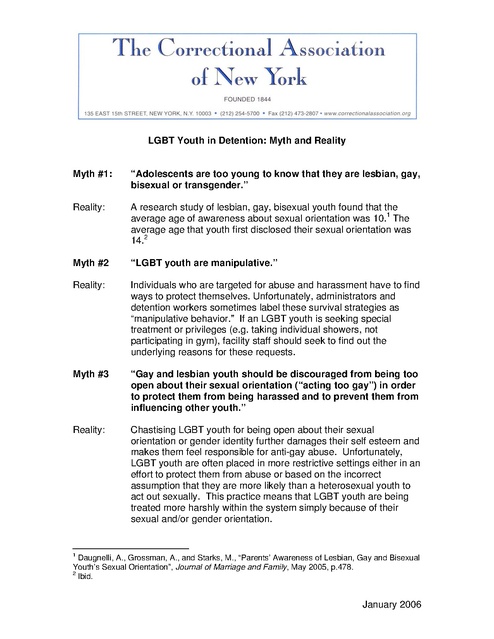The Correctional Association of Ny Publication Lgbt Myths and Reality Jan 2006
Download original document:

Document text

Document text
This text is machine-read, and may contain errors. Check the original document to verify accuracy.
LGBT Youth in Detention: Myth and Reality Myth #1: “Adolescents are too young to know that they are lesbian, gay, bisexual or transgender.” Reality: A research study of lesbian, gay, bisexual youth found that the average age of awareness about sexual orientation was 10.1 The average age that youth first disclosed their sexual orientation was 14.2 Myth #2 “LGBT youth are manipulative.” Reality: Individuals who are targeted for abuse and harassment have to find ways to protect themselves. Unfortunately, administrators and detention workers sometimes label these survival strategies as “manipulative behavior.” If an LGBT youth is seeking special treatment or privileges (e.g. taking individual showers, not participating in gym), facility staff should seek to find out the underlying reasons for these requests. Myth #3 “Gay and lesbian youth should be discouraged from being too open about their sexual orientation (“acting too gay”) in order to protect them from being harassed and to prevent them from influencing other youth.” Reality: Chastising LGBT youth for being open about their sexual orientation or gender identity further damages their self esteem and makes them feel responsible for anti-gay abuse. Unfortunately, LGBT youth are often placed in more restrictive settings either in an effort to protect them from abuse or based on the incorrect assumption that they are more likely than a heterosexual youth to act out sexually. This practice means that LGBT youth are being treated more harshly within the system simply because of their sexual and/or gender orientation. 1 Daugnelli, A., Grossman, A., and Starks, M., “Parents’ Awareness of Lesbian, Gay and Bisexual Youth’s Sexual Orientation”, Journal of Marriage and Family, May 2005, p.478. 2 Ibid. January 2006 Myth #4: “Kids pick on each other for a range of things (being too fat, living in another neighborhood, having a big nose) so being picked on for being gay is no different.” Reality: It is true that no form of bullying should be tolerated. However, it is also important to specifically address homophobia within the facility. LGBT youth have often been rejected by their families and harassed at school. It is important to stem this cycle of harassment and mistreatment. Myth #5: “LGBT youth in our detention centers never complain about mistreatment. This must mean that they are being treated fine.” Reality: Don’t misinterpret “no news” as “good news.” The reality is that teenagers are less likely to make complaints than adults – especially if they don’t feel that adult staff members are sympathetic to their concerns. Even if you don’t hear complaints from LGBT youth, it is important to be proactive by having a comprehensive anti-discrimination policy and by offering antihomophobia training for staff and residents. Myth #6: “LGBT youth must be separated from the general population to ensure their safety.” Reality: Facility staff should not rely on administrative segregation or isolation to protect the safety of LGBT youth. These policies only serve to punish LGBT youth. Rather, the safety of residents is best assured by adequate staffing and meaningful programming.3 Myth #7: “The only way to provide a safe environment for LGBT youth is to create separate group homes or housing areas exclusively for LGBT youth.” Reality: Specialized group homes are an important resource for LGBT youth.4 These group homes often provide an affirming and safe environment. However, it should not be assumed that all LGBT youth wish to be placed in a separate facility. In fact, some youth may not wish to be placed in these facilities because they do not wish to disclose their sexual orientation. In addition, the existence of these facilities should not absolve the detention system from its larger responsibility to create safe, inclusive environments in all their facilities. 3 Wilber, S., Reyes, C. and Marksamer, J. “Model Standards Project: Creating Inclusive Systems for LGBT Youth in Out-of-Home Care” Child Welfare League of America, 2005, p. 8. 4 Ibid., p. 7. January 2006 Myth #8: “As a matter of policy, facility staff members do not call youth by nicknames or street names, so we can’t call transgender youth by the name they preferred to be called.” Reality: Allowing transgender youth to use names in accordance with their gender identity is essential to helping young people develop a sense of self worth. It may also help prevent violence and harassment by encouraging other youth to treat transgender youth with respect.5 Myth #9: “We cannot allow transgender youth to wear clothing according to their gender identity because this may arouse the other youth.” Reality: Like names and pronouns, clothing is an important signifier of gender. If the facility allows youths to wear their own clothing, transgender youth should be allow to dress according to their gender identity. Myth #10: “We do not discuss homosexuality in the facility because we do not want to encourage residents to have sexual relations within the facility.” Curiosity about one’s sexuality is an aspect of healthy adolescent development. Staff should be appropriately trained to discuss questions about sexuality, sexual orientation and gender identity with all youth. 5 Ibid., p.6. January 2006

